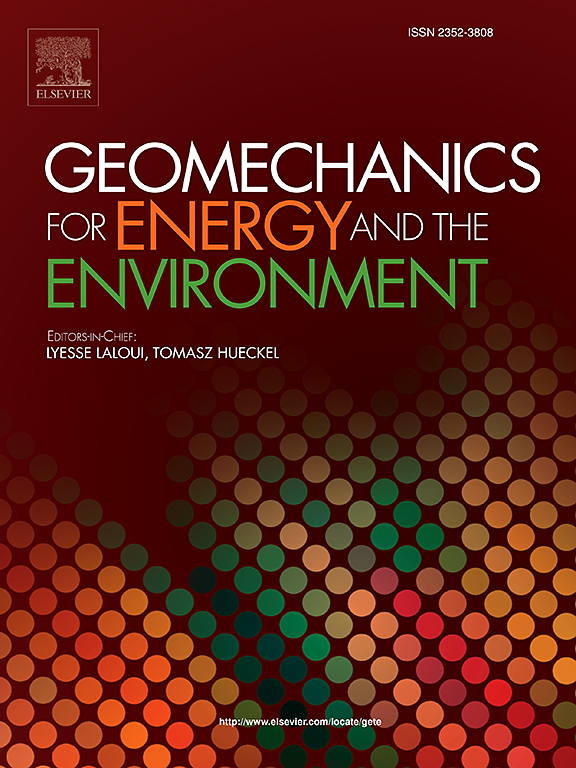Energy quay walls: Performance analysis and optimisation
IF 3.7
2区 工程技术
Q3 ENERGY & FUELS
引用次数: 0
Abstract
Energy Quay Walls (EQWs) are innovative energy geostructures with the unique capability to exchange heat with both soil and open water. Although previous laboratory testing demonstrated a promising energy efficiency for this type of system, its novelty necessitated thorough research to advance comprehension of its thermal behaviour and optimise energy efficiency. This paper conducts an in-depth examination of EQWs, employing numerical models validated against real data from a full scale test in Delft, The Netherlands.
Two Finite Element numerical models were developed to (i) reconstruct the undisturbed (i.e. pre-geothermal activation) temperature profile within the soil and (ii) conduct a comprehensive (3D) analysis of heat exchange processes in an EQW application (i.e. during geothermal activation), calibrating relevant parameters with field test data, providing valuable insights into its energy efficiency. Following validation, the geothermal activation model was employed to assess the impact of the flow regime within the heat exchanger pipes and the velocity of the open water on the energy efficiency of the EQW system. Additionally, the contributions of soil, water, and air to the energy gain are investigated. The results indicate that the primary source of energy gain is from open water, and the dominance of this contribution is further increased by the presence of turbulent flow within the heat exchanger pipes. However, the soil can play a key role in short term energy delivery. Furthermore, this study emphasises the importance of the open water movement, revealing a 48 reduction in energy extraction for fully stationary water scenarios.
能源码头墙:性能分析和优化
能源码头墙(eqw)是一种创新的能源土工结构,具有与土壤和开阔水域交换热量的独特能力。虽然之前的实验室测试表明,这种类型的系统具有良好的能源效率,但其新颖性需要深入研究,以促进对其热行为的理解,并优化能源效率。本文对eqw进行了深入的研究,采用数值模型对荷兰代尔夫特的全尺寸试验的真实数据进行了验证。开发了两个有限元数值模型,用于(i)重建土壤内未受干扰(即地热激活前)的温度剖面;(ii)对EQW应用(即地热激活期间)的热交换过程进行全面(3D)分析,用现场测试数据校准相关参数,为其能源效率提供有价值的见解。在验证之后,地热活化模型被用来评估热交换器管道内的流动状态和开放水的速度对EQW系统能源效率的影响。此外,还研究了土壤、水和空气对能量增益的贡献。结果表明,开阔水域是能量增益的主要来源,而换热器管内湍流的存在进一步增加了这一贡献的主导地位。然而,土壤可以在短期能源输送中发挥关键作用。此外,该研究强调了开放水域运动的重要性,揭示了完全静止水域情景下能源提取减少48%。
本文章由计算机程序翻译,如有差异,请以英文原文为准。
求助全文
约1分钟内获得全文
求助全文
来源期刊

Geomechanics for Energy and the Environment
Earth and Planetary Sciences-Geotechnical Engineering and Engineering Geology
CiteScore
5.90
自引率
11.80%
发文量
87
期刊介绍:
The aim of the Journal is to publish research results of the highest quality and of lasting importance on the subject of geomechanics, with the focus on applications to geological energy production and storage, and the interaction of soils and rocks with the natural and engineered environment. Special attention is given to concepts and developments of new energy geotechnologies that comprise intrinsic mechanisms protecting the environment against a potential engineering induced damage, hence warranting sustainable usage of energy resources.
The scope of the journal is broad, including fundamental concepts in geomechanics and mechanics of porous media, the experiments and analysis of novel phenomena and applications. Of special interest are issues resulting from coupling of particular physics, chemistry and biology of external forcings, as well as of pore fluid/gas and minerals to the solid mechanics of the medium skeleton and pore fluid mechanics. The multi-scale and inter-scale interactions between the phenomena and the behavior representations are also of particular interest. Contributions to general theoretical approach to these issues, but of potential reference to geomechanics in its context of energy and the environment are also most welcome.
 求助内容:
求助内容: 应助结果提醒方式:
应助结果提醒方式:


